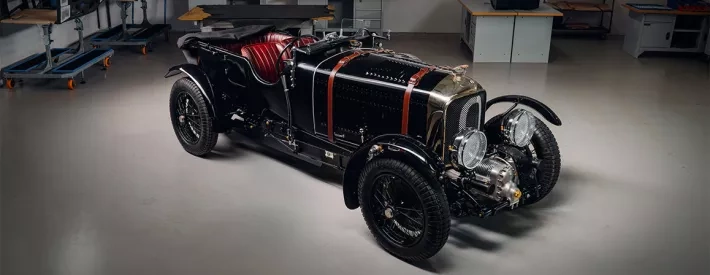Bentley blows off the cobwebs

Bentley is bringing back its famous Blower as part of a continuation line, developed from original drawings, tooling and data taken from a laser-scanned CAD model of the marque’s own 1929 Team Car
It’s back. After 90 years Bentley has completed the first Blower, one of the most iconic vehicles to ever roll off the company’s production line. The vehicle, known as Car Zero, required 40,000 hours of work and is the prototype car for the Blower Continuation Series.
The exclusive run of 12 customer cars – all pre-sold - will be crafted from the design drawings and tooling jigs used for the original four Blowers built and raced by Sir Henry ‘Tim’ Birkin in the late 1920s. Specifically, Bentley’s own Team Car provided the master model for the Continuation Series, with every single component laser-scanned as part of a wheels-up, sympathetic restoration.
From this data, 1,846 individual parts were designed and hand-crafted to create the new Blower. 230 of those parts are actually assemblies – one of which being the engine – taking the total part count to several thousand when fixings and interior trim parts are included. Each of these parts and assemblies have been created by a project team of Bentley engineers, craftspeople and technicians working together with a number of British specialists and suppliers.
Blower Car Zero is a dedicated test and development prototype, and will now face months of durability and performance testing to make sure its development has been spot on and the customer cars meet the quality criteria demanded by both the company and those paying for them.
A project of draftsmen and craftsmen
The first step in creating Car Zero was an extensive analysis of the original design drawings and drafts that were referenced in the creation of the original Blower Team Cars, together with archived period photographs of the cars. Following a piece-by-piece disassembly of Bentley’s Team Car and precise laser scanning of the frame and its components, a complete digital CAD model of the Blower was created.
From there, a team of artisan specialists were recruited to start manufacturing components.
The chassis is heavy-gauge steel, hand-formed and hot riveted by the specialists at Israel Newton & Sons Ltd. This 200-year old company, based near Derby, traditionally makes boilers for steam locomotives and traction engines, but puts its talents to something a little different for this project.
The Vintage Car Radiator Company, based at Bicester Heritage, has crafted exact recreations of some of the Blower’s key components including the mirror-polished, solid nickel silver radiator shell and the hand-beaten fuel tank formed in steel and copper.
Leaf springs and shackles are made to original specifications by Jones Springs Ltd, while the Blower’s iconic headlamps have been reborn by Vintage Headlamp Restoration International Ltd in Sheffield. The father and son team is world-renowned for their silversmithing and ability to create vintage-design headlamps from original specifications.
Bringing back an iconic engine
Car Zero’s brand new 4½-litre engine, originally designed by W.O Bentley himself, has been created with the expert support of specialists including NDR Ltd in Watford. Featuring many innovations of which a sports car engine of the 1970s would be proud – aluminium pistons, an overhead camshaft, four valves per cylinder and twin spark ignition – the renowned 4½-litre engine has been paired with a newly machined Amherst Villiers roots-type supercharger. The newly created Blower engine is an exact recreation of the engines that powered Tim Birkin’s four Team Blowers that raced in the late 1920s – including the use of magnesium for the crankcase.
While the first engine was being assembled, work was also underway to convert an engine testbed at Bentley’s Crewe headquarters to accept the nearly 100-year old engine design. The engine test facility has been at Bentley since the factory was built in 1938, and the cells were originally used to run-in and power-test Merlin V12 aero engines produced by the factory for the Spitfire and Hurricane fighters of the Second World War.
Preparing the test bed involved making a replica Blower front chassis to hold the engine, which could then be mounted to the computer-controlled engine dynamometer. A new software version to measure and control the engine was written and tested, allowing Bentley’s engineers to monitor and run the engine to precise parameters. As the Blower powertrain is considerably different in size and shape to Bentley’s modern production engines, a number of the original Merlin testbed fixtures – still in storage at Bentley - have been utilised to adapt the testbed to accommodate these special engines.
With the engine fully installed, the engine was put through a defined schedule of run-in ahead of fitment to the car.
What’s next?
With the build of Car Zero now complete, a programme of real-world durability testing will begin. Sessions of gradually increasing duration and speed will check functionality and robustness under ever harder conditions. The test programme is designed to achieve the equivalent of 35,000km of real-world driving across 8,000km of track driving, and simulates the undertaking of famous rallies such as Peking to Paris and Mille Miglia. The testing will also see a particularly brave driver taking the car to its top speed.




